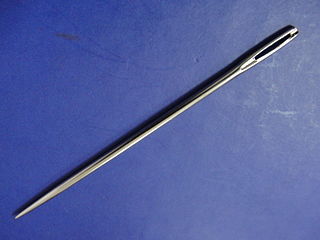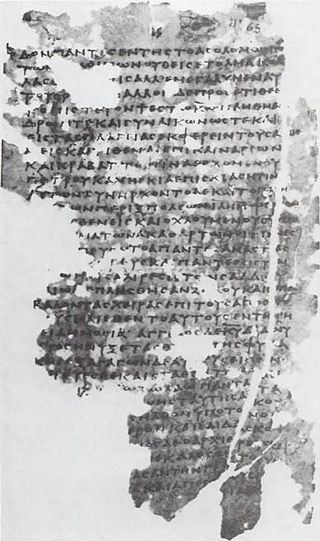The New Testament (NT) is the second division of the Christian biblical canon. It discusses the teachings and person of Jesus, as well as events relating to first-century Christianity. The New Testament's background, the first division of the Christian Bible, is called the Old Testament, which is based primarily upon the Hebrew Bible; together they are regarded as sacred scripture by Christians.
Alexander Neckam was an English magnetician, poet, theologian, and writer. He was an abbot of Cirencester Abbey from 1213 until his death.

The Gospel of Nicodemus, also known as the Acts of Pilate, is an apocryphal gospel claimed to have been derived from an original Hebrew work written by Nicodemus, who appears in the Gospel of John as an associate of Jesus. The title "Gospel of Nicodemus" is medieval in origin. The dates of its accreted sections are uncertain, but the work in its existing form is thought to date to around the 4th or 5th century AD.

The Apocalypse of Peter, also called the Revelation of Peter, is an early Christian text of the 2nd century and an example of apocalyptic literature with Hellenistic overtones. It is not included in the standard canon of the New Testament, but is mentioned in the Muratorian fragment, the oldest surviving list of New Testament books, which also states that some authorities would not have it read in church. The text is extant in two incomplete versions of a lost Greek original, a later Greek version and an Ethiopic version, which diverge considerably. The work is classed as part of New Testament apocrypha.
Achilles Tatius of Alexandria was a Roman-era Greek writer of the 2nd century AD whose fame is attached to his only surviving work, the ancient Greek novel, or romance, The Adventures of Leucippe and Clitophon.

A sewing needle, used for hand-sewing, is a long slender tool with a pointed tip at one end and a hole to hold the sewing thread. The earliest needles were made of bone or wood; modern needles are manufactured from high carbon steel wire and are nickel- or 18K gold-plated for corrosion resistance. High-quality embroidery needles are plated with two-thirds platinum and one-third titanium alloy. Traditionally, needles have been kept in needle books or needlecases which have become objects of adornment. Sewing needles may also be kept in an étui, a small box that held needles and other items such as scissors, pencils and tweezers.

The New Testament apocrypha are a number of writings by early Christians that give accounts of Jesus and his teachings, the nature of God, or the teachings of his apostles and of their lives. Some of these writings were cited as scripture by early Christians, but since the fifth century a widespread consensus has emerged limiting the New Testament to the 27 books of the modern canon. Roman Catholic, Eastern Orthodox, and Protestant churches generally do not view the New Testament apocrypha as part of the Bible.
The Holy Bible from Ancient Eastern Manuscripts was published by George M. Lamsa in 1933. It was derived, both Old and New Testaments, from the Syriac Peshitta, the Bible used by the Assyrian Church of the East and other Syriac Christian traditions.

The Acts of Peter is one of the earliest of the apocryphal Acts of the Apostles in Christianity, dating to the late 2nd century AD. The majority of the text has survived only in the Latin translation of the Codex Vercellensis, under the title Actus Petri cum Simone. It is notable for a description of a miracle contest between Saint Peter and Simon Magus, the first record of the tradition that Saint Peter was crucified head-down, and as the origin of the saying Quo vadis?

The Acts of Andrew, is a Christian apocryphal work describing acts and miracles of Andrew the Apostle. It is alluded to in a Coptic 3rd-century work entitled the Manichaean Psalm Book, so it must have been composed prior to that century. By the 4th century, the stories told in the book were considered apocryphal, and the book was relegated to the New Testament apocrypha.

The term "eye of a needle" is used as a metaphor for a very narrow opening. It occurs several times throughout the Talmud. The New Testament quotes Jesus as saying in Luke 18:25 that "it is easier for a camel to go through the eye of a needle than for a rich man to enter the kingdom of God". It also appears in the Qur'an 7:40, "Indeed, those who deny Our verses and are arrogant toward them – the gates of Heaven will not be opened for them, nor will they enter Paradise until a camel enters into the eye of a needle. And thus do We recompense the criminals."

The Acts of Paul is one of the major works and earliest pseudepigraphal series from the New Testament apocrypha also known as Apocryphal Acts. This work is part of a body of literature either about or purporting to be written by Paul the Apostle, including letters, narratives, prayers, and apocalypses. An approximate date given to the Acts of Paul is 100-160 AD. The Acts of Paul were first mentioned by Tertullian, who deemed the work to be heretical. He mentioned that that the writings "wrongly go under Paul's name" and was "augmenting Paul's fame from his own store". Eusebius wrote than, unlike other writings which were classified as antilegomena in some instances, the Acts of Paul were always classified among the disputed. The Acts of Paul may have been considered orthodox by Hippolytus of Rome but were eventually regarded as heretical when the Manichaeans started using the texts. The author of the Acts of Paul is unknown, but probably came from a Christian community in Asia Minor that revered Paul. The work does not use the canonical Acts of the Apostles as a source; instead it relies on oral traditions of Paul's missionary work. The text is primarily known from Greek manuscripts. The discovery of a Coptic language version of the text demonstrated that the text was composed of:
The Three Princes of Serendip is the English version of the story Peregrinaggio di tre giovani figliuoli del re di Serendippo, published by Michele Tramezzino in Venice in 1557. Tramezzino claimed to have heard the story from one Cristoforo Armeno, who had translated the Persian fairy tale into Italian, adapting Book One of Amir Khusrau's Hasht-Bihisht of 1302. The story first came to English via a French translation, and now exists in several out-of-print translations. Serendip is the Classical Persian name for Sri Lanka (Ceylon).

Coptic literature is the body of writings in the Coptic language of Egypt, the last stage of the indigenous Egyptian language. It is written in the Coptic alphabet. The study of the Coptic language and literature is called Coptology.

Camel Through the Eye of a Needle is a 1936 Czech comedy film directed by and starring Hugo Haas. The title is an allusion to the "eye of a needle" aphorism. It's a second movie adaptation of the play by František Langer after the 1926 film Never the Twain.
Nikolai Aldunin is a Russian artist noted for his microscopic art described as "masterpieces" and "pioneering work", "famous in Russia and around the world". His work includes a T-34 tank a fraction of the size of an apple seed and composed of more than 200 pieces, made of pure gold and described as "perfect copy of a real vehicle"; a gold saddle and horseshoes for a flea; and a camel train in the eye of a needle.

Jesus and the rich young man is an episode in the life of Jesus recounted in the Gospel of Matthew 19:16–30, the Gospel of Mark 10:17–31 and the Gospel of Luke 18:18–30 in the New Testament. It deals with eternal life and the world to come.

Saint Peter, also known as Peter the Apostle, Simon Peter, Simeon, Simon, or Cephas, was one of the Twelve Apostles of Jesus Christ and one of the first leaders of the early Christian Church. He appears repeatedly and prominently in all four New Testament gospels as well as the Acts of the Apostles. Catholic tradition accredits Peter as the first bishop of Rome—or pope—and also as the first bishop of Antioch.

Acts 4 is the fourth chapter of the Acts of the Apostles in the New Testament of the Christian Bible. The book containing this chapter is anonymous but early Christian tradition affirmed that Luke composed this book as well as the Gospel of Luke. This chapter records the aftermath of a healing by Simon Peter and his preaching in Solomon's Portico, that Sanhedrin arrested the apostles, but had to let them go.

Acts 5 is the fifth chapter of the Acts of the Apostles in the New Testament of the Christian Bible. It records the growth of the early church and the obstacles it encountered.










